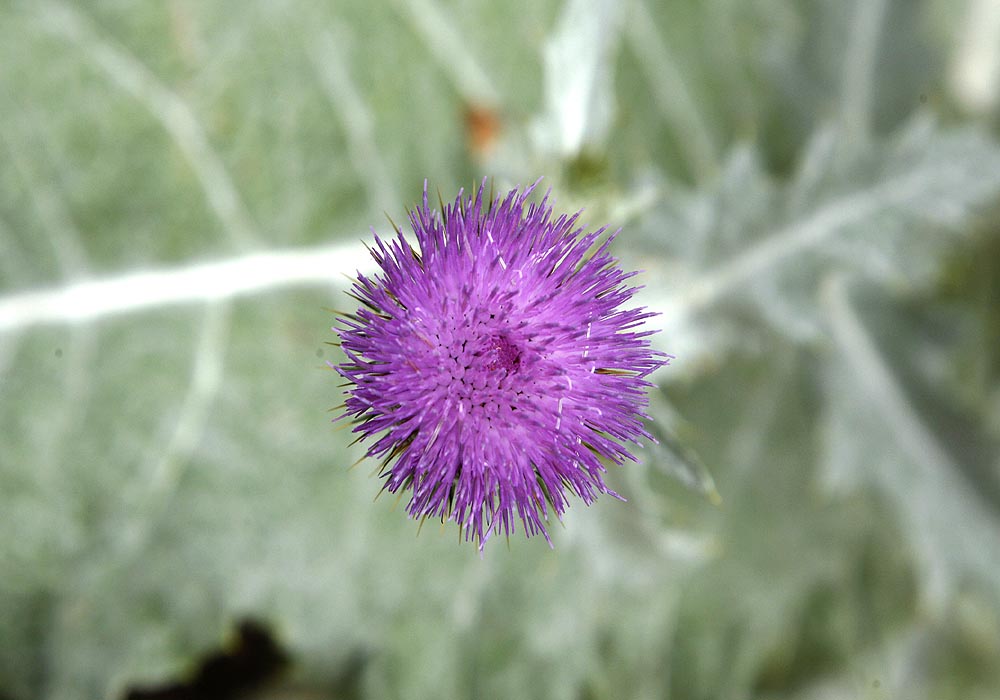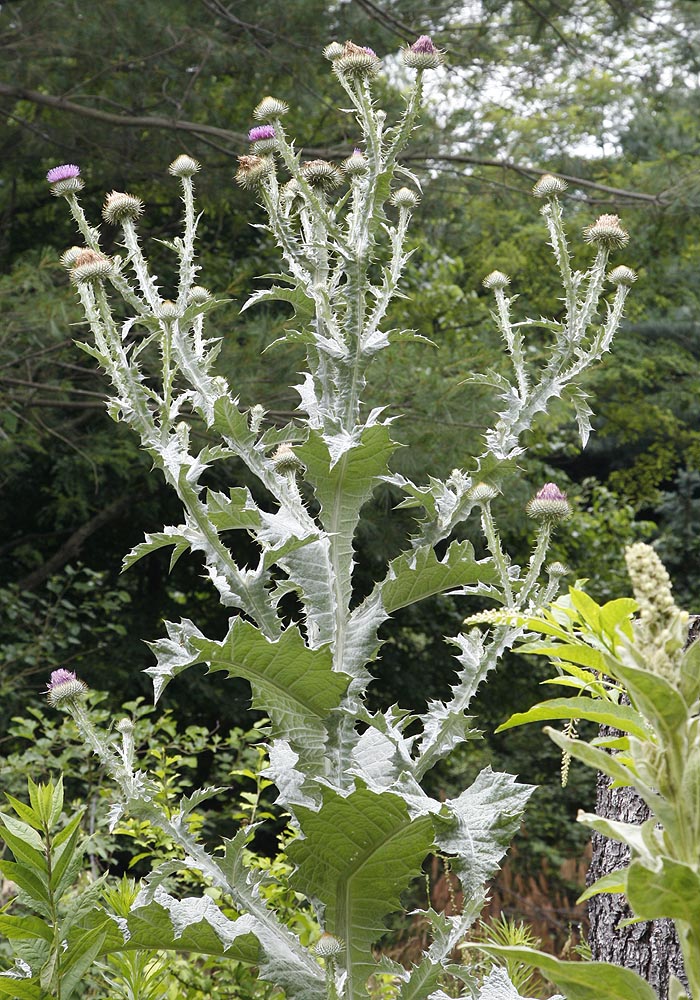A magnificent plant. The Scotch Thistle - the National flower of Scotland. Can reach 8-10 feet in height. It has large triangular stems and huge silver blue leaves that will stand out from a great distance. Add to this the lovely purple violet flowers and this makes a plant that attracts everyone to admire it. It makes a wonderful focal point plant and is very easy to grow. It needs sunlight and water but is happy on poor soil and due to the very nasty spines is not troubled by any animals. It's a biennial so to keep a display going it is necessary to plant every year but its well worth it. The flowers are loved by butterflies and bees and the goldfinches love the seeds.
Warning. Scotch thistles can get out of control and in some areas are considered a noxious weed, while in others a wonderful majestic plant that needs to be protected. Take care to control the seeds by deadheading your plant to ensure it does not drop seed and get away from your garden.
Mostly the Scotch thistle acts as a biennial. However in some case it will flower in one year and act as an annual.In the first year the plant produces a flattened rosette of silvery leaves that can reach two feet long and a foot wide. These are broadly elliptic, coarsely lobed, sharply spined and covered with silver gray hairs that give the leaves a velvety appearance. During this first year the plant is producing a large fleshy tap root. The leaves will overwinter giving an interesting silvery appearance.
In the second year it puts up a central stem triangular stem that is silver gray in color and again covered with hairs and spines. The leaves are attached alternately on the stem without a stalks and form leaf wings that extend down the stem. The stalk becomes very branched with each branch ending in a solitary flower. These can be up to two inches across with spiny tipped bracts. The flowers are purple to violet in color and appear from July through September. Flower stalks can reach 8 feet in height in some conditions they can go as high as 10 feet. Flowers are attractive to butterflies and bees. The large seeds are a favorite of goldfinches.
Once started the seedlings tend to grow slowly to begin creating a solid rootstock the first year ready to flower in the second. The wait is well worth it.
Seeds can be sown directly into the desired spot or they can be sown in pots and later transplanted. There are advantages and disadvantages to each method.
Advantages. Its easy to plant and you don't have to bother with any special stratification during the winter months let nature do it for you. This way almost all the seeds will germinate.
Disadvantages. The seedling are often quite small to begin with and slow to get going. Weeding out the area and not accidently pulling out the thistle seedlings can be tough especially as you need to do so for two years.
If you don't want to sow all your seeds at once put the rest in the refrigerator to keep them at their best until you need them.
Sow in potting soil that will retain the moisture and not dry out too fast but will not remain soggy. Place in a warm but not hot location with plenty of light. Some seeds will germinate immediately its never possible to tell how many will do so.
For those that don't germinate immediately it may be necessary to keep the pots over the winter. If this is the case label each pot with a marked stick (you will forget what is in it otherwise). Place in a location where it will receive moisture over the winter months but will not be disturbed. Choose a secure location or wildlife may dig up the seeds and eat them. Leave the pots over the winter. It does not matter if they freeze, have snow on them or even dry out occasionally.
In spring bring the pots back up to a bench or somewhere you can keep an eye on them, water and keep moist. Almost all the rest of the seeds will sprout at this time.
In all cases allow the seedlings to reach at least two inches and be fairly robust before planting out. Take care not to disturb the roots when transplanting. Ensure that the soil is well watered before removing from the pot, this helps keep the soil on the roots and disturb them less. Dig a large enough hole to put the root ball in directly.
Advantages of this method. It's easy to keep an eye on the seedlings and see when they are germinating. Since they are slow starters it helps to maintain them until they are ready to be planted out. Seeds that need to be stratified can be easily checked on. Plants can be nurtured until they are large enough to be planted out.
Disadvantages. For those seeds that did not germinate immediately somewhere is needed to keep the pots and not be forgotten. Keeping wildlife away can sometimes be a problem. Remembering what you planted and where you put the pots can also sometimes be a challenge.
We once accidently left a cell tray of thistles in our unheated pot house over the winter months. They were not watered and totally dried out during the winter and froze solid for at least a month, then froze and thawed for a while too. Come spring we found the tray and watered it, all the seedlings germinated.
Once the plant is in the ground do not try to transplant. The large fleshy taproot is not easily removed without damage and the plants to not transplant well once they are larger. Pick your location carefully and stick with it.
Thistle rosettes are great for keeping down the weeds but do benefit from a little mulch at the end of their first year to ensure that they will grow large in their flowering year. This also helps keep the weeds away from around the plant, since these plants are so prickly going near it to weed can be an unpleasant experience.
Cut the plants down with loppers once the flowers have finished. You can use the lopper to pick up the stem and move to your compost heap or discard pile.
If you want to keep a display of thistles you will need to seed every year to ensure that you have plants in the rosette stage and the flowering stage each year. These plants do well in the same spot year after year. IF they start to get a little smaller add a little mulch in the fall around the plants and they will grow taller.
The best way is to deadhead the plant once the flowers are finished. To do this put on the thickest pair of gloves you own. Use scissors, floral snips, or if you want to stay even further from the plant, small loppers to remove the dead flower heads from the plant. This will keep it flowering longer and prevent it from spreading. Keep some flowers to produce seeds if you want to keep the thistles each year. If using pruners with a little practice you can catch the pruned head on the pruners and place directly in a bucket to prevent them falling to the ground. IF they do fall pick them up with pruners or loppers, don't use even your gloved hands as they can get you even through gloves. The thistle head are great on the compost heap, just take care when turning your compost before the leaves have rotted down a bit.








